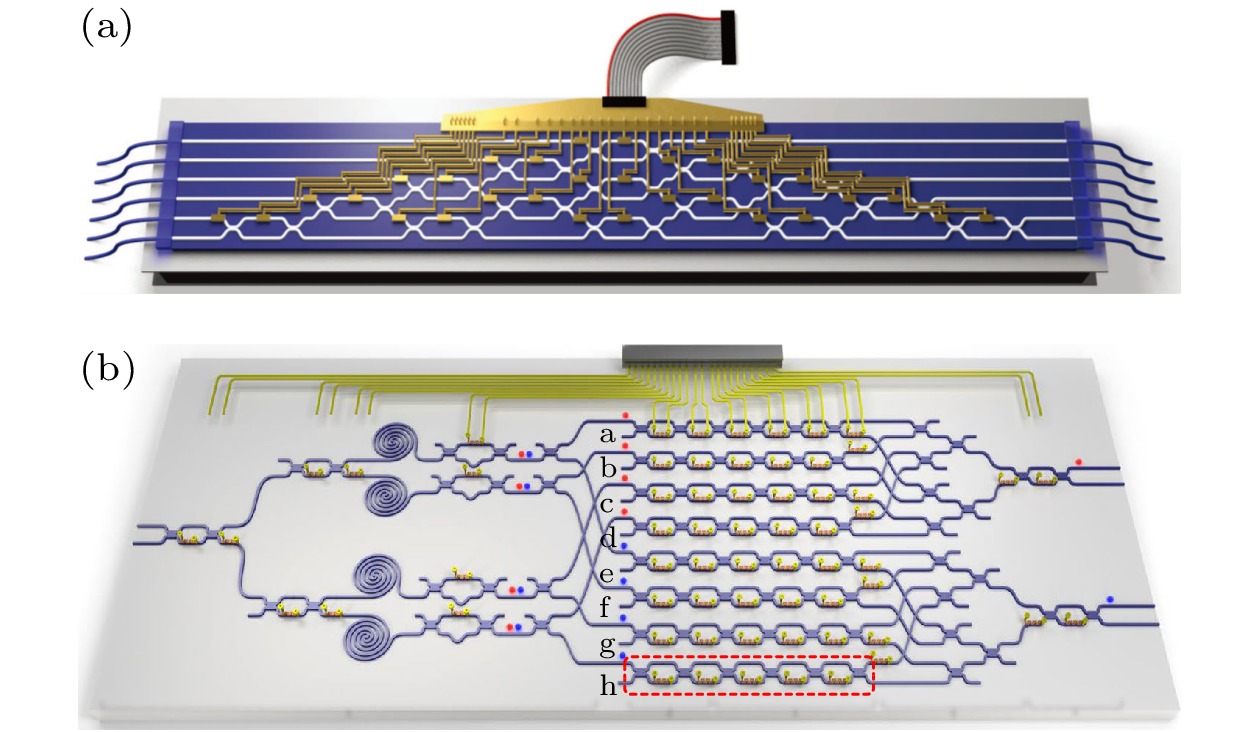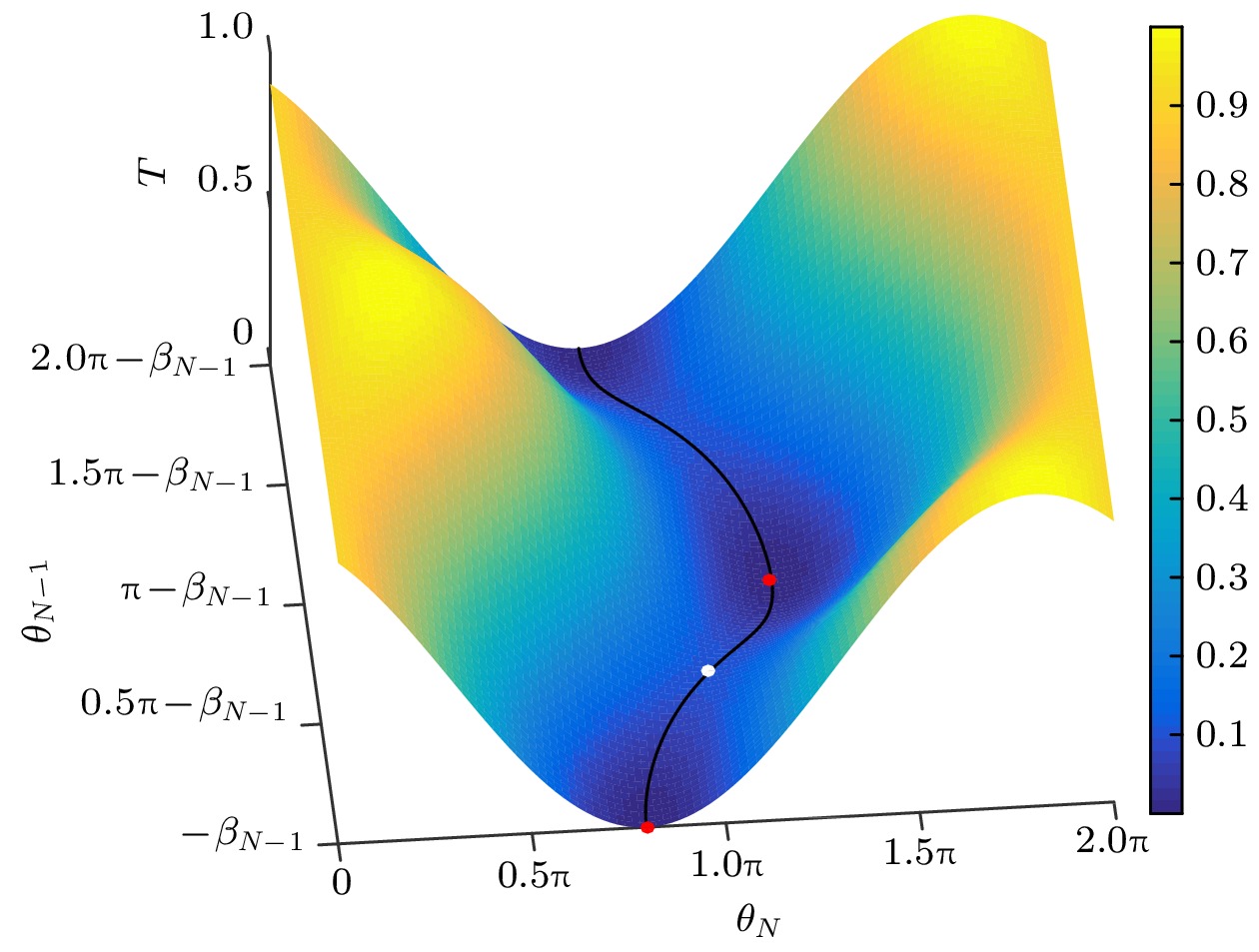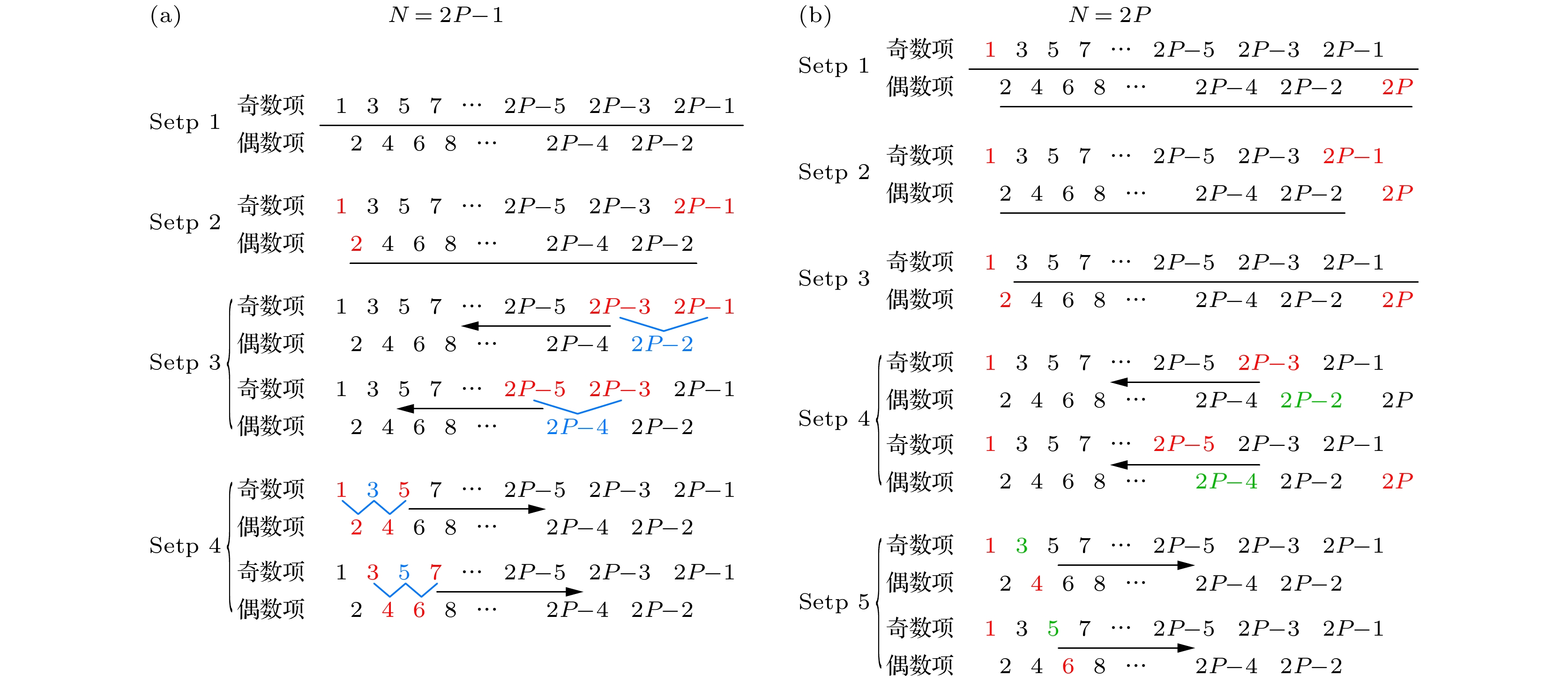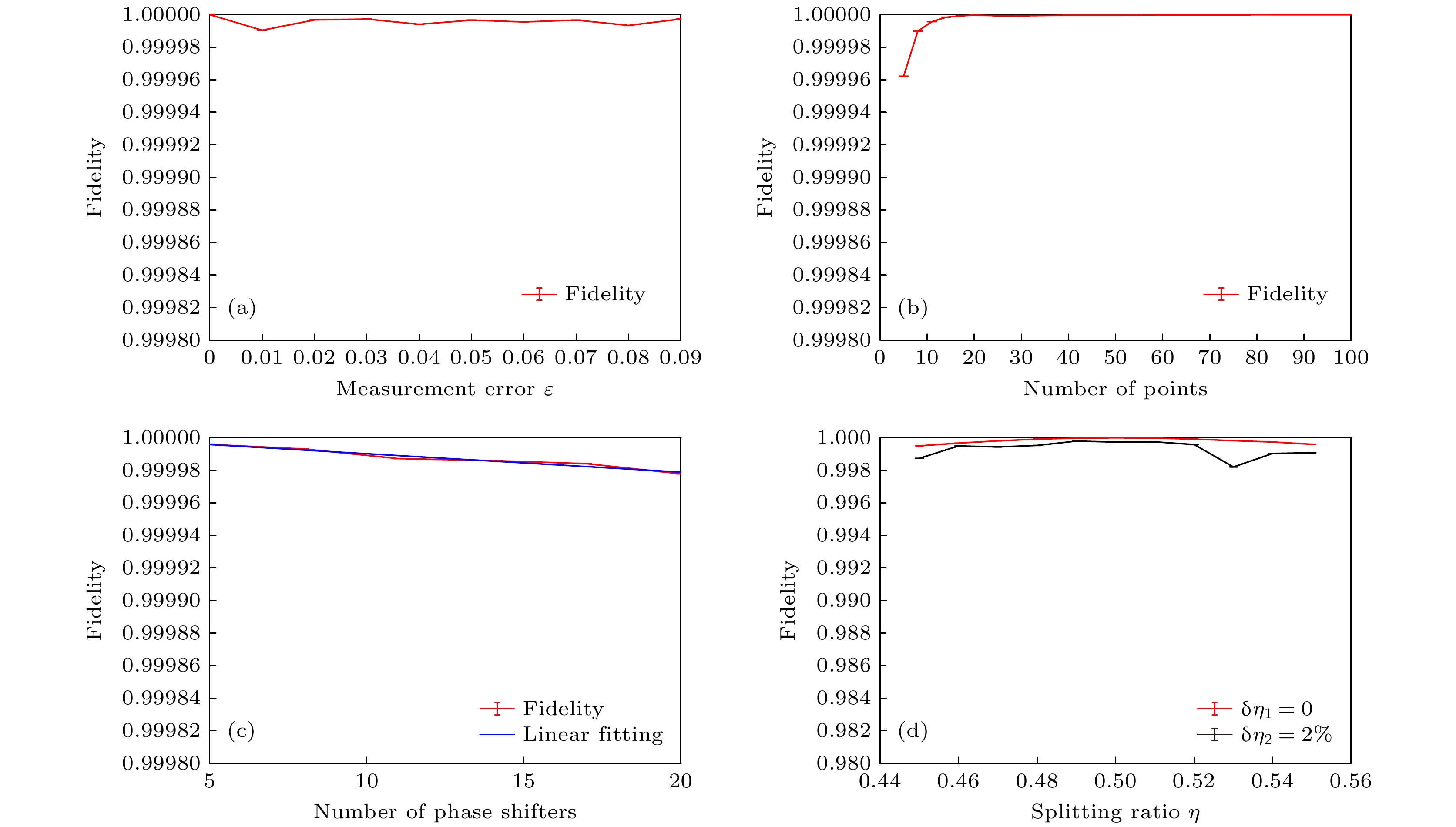-
Integrated photonics has the advantages of miniaturization, low cost, stability and easy manipulation in comparison with bulk optics. However, as the scale and complexity of the chip increase, the calibration of cascaded phase shifters on-chip will be almost impossible. The time needed to calibrate the cascaded phase shifters with using conventional method increases exponentially with the number of cascades, and the maximum number of cascades achieved so far is only 5. In this paper, we propose a high-speed calibration method by which the calibration time increases only linearly with the number of cascades increasing, achieving an exponential acceleration. For N-cascaded phase shifters, the number of points scanned by each shifter is m, our method only needs to scan
$ ({m}^{2}+m+1)N-1 $ points instead of$ {m}^{n} $ with using the proposed method. The main idea of this method is that we can calibrate phase shifters one by one via two-dimensional (2D) scanning. For example, for N-cascaded phase shifter, the calibration of phase shifter N can be realized by calibrating the 2D scanning phase shifter$ N-1 $ and the 2D scanning phase shifter N, and the calibration of phase shifter$ N-1 $ can be achieved by calibrating the 2D scanning phase shifter$ N-2 $ and the 2D scanning phase shifter$ N-1 $ , and so on. The 2D scanning phase shifter$ N-1 $ and the 2D scanning phase shifter N scan the phase shifter N by m points and then the current of phase shifter$ N-1 $ is changed to scan the phase shifter N. Whenever changing the current of phase shifter$ N-1 $ once, we can plot a curve of current-transmission. The lowest point of the curve changes with the change of the current phase shifter$ N-1 $ . When the lowest point of the curve takes a maximum value, that point is the 0 or π phase of phase shifter N. Similarly, when the lowest point of the curve takes a maximum value, that point is the$ -0.5{\rm{\pi }} $ or$ 0.5{\rm{\pi }} $ phase of phase shifter$ N-1 $ . Then we can calibrate all phase shifters by using this method, but each phase shifter has two possibilities. Then we can set a specific current of all phase shifters to finish the calibration. The different parameters are verified to see their effect on fidelity. It is found that small experimental error has little effect on fidelity. When$ m > 20 $ , the fidelity becomes approximately a constant. For every 1760 increase in N, the fidelity decreases by about 0.01%. The fidelity of 20-cascaded phase shifters is 99.8%. The splitting ratio of MMI may is not 50∶50 as designed because of chip processing errors. So, different splitting ratios are simulated and it is found that the splitting ratio affects the fidelity more seriously than other parameters. But our method works still well even when the splitting ratio is 45∶55, whose fidelity is 99.95% if we know the splitting ratio. The method will greatly expand the application scope of integrated quantum photonics.[1] Gisin N, Ribordy G, Tittel W, Zbinden H 2002 Rev. Mod. Phys. 74 145
 Google Scholar
Google Scholar
[2] Xu F H, Ma X F, Zhang Q, Lo H K, Pan J W 2020 Rev. Mod. Phys. 92 025002
 Google Scholar
Google Scholar
[3] Wei K J, Li W, Tan H, Li Y, Min H, Zhang W J, Li H, You L X, Wang Z, Jiang X, Chen T Y, Liao S K, Peng C Z, Xu F H, Pan J W 2020 Phys. Rev. X 10 031030
[4] Yin J, Li Y H, Liao S K, et al. 2020 Nature 582 501
 Google Scholar
Google Scholar
[5] Bennett C H, Brassard G 1984 Proceedings of the International Conference on Computers, Systems and Signal Processing Bangalore, India December 9−12, 1984 p175
[6] Ladd T D, Jelezko F, Laflamme R, Nakamura Y, Monroe C, O’Brien J L 2010 Nature 464 45
 Google Scholar
Google Scholar
[7] Zhong H S, Wang H, Deng Y H, et al. 2020 Science 370 1460
[8] Bentivegna M, Spagnolo N, Vitelli C, et al. 2015 Sci. Adv. 1 e1400255
 Google Scholar
Google Scholar
[9] Ciampini M A, Orieux A, Paesani S, Sciarrino F, Corrielli G, Crespi A, Ramponi R, Osellame R, Mataloni P 2016 Light-Sci. Appl. 5 e16064
 Google Scholar
Google Scholar
[10] [11] Grover L K 1997 Phys. Rev. Lett. 79 325
 Google Scholar
Google Scholar
[12] Aspuru-Guzik A, Walther P 2012 Nat. Phys. 8 285
 Google Scholar
Google Scholar
[13] Sparrow C, Martin-Lopez E, Maraviglia N, Neville A, Harrold C, Carolan J, Joglekar Y N, Hashimoto T, Matsuda N, O’Brien J L, Tew D P, Laing A 2018 Nature 557 660
 Google Scholar
Google Scholar
[14] Zhong Y P, Chang H S, Biefait A, Dumur E, Chou M H, Conner C R, Grebel J, Povey R G, Yan H X, Schuster D I, Cleland A N 2021 Nature 590 571
 Google Scholar
Google Scholar
[15] Song C, Xu K, Li H K, Zhang Y R, Zhang X, Liu W X, Guo Q J, Wang Z, Ren W H, Hao J, Feng H, Fan H, Zheng D N, Wang D W, Wang H, Zhu S Y 2019 Science 365 574
 Google Scholar
Google Scholar
[16] Bohnet J G, Sawyer B C, Britton J W, Wall M L, Rey A M, Feig M F, Bollinger J J 2016 Science 352 1297
 Google Scholar
Google Scholar
[17] Wang H, Qin J, Ding X, Chen M C, Chen S, You X, He Y M, Jiang X, You L, Wang Z, Schneider C, Renema J J, Höfling S, Lu C Y, Pan J W 2019 Phys. Rev. Lett. 123 250503
 Google Scholar
Google Scholar
[18] Liu W Z, Li M H, Ragy S, Zhao S R, Bai B, Liu Y, Brown P J, Zhang J, Colbeck R, Fan J Y, Zhang Q, Pan J W 2021 Nat. Phys 17 448
 Google Scholar
Google Scholar
[19] Li Z P, Huang X, Cao Y, Wang B, Li Y H, Jin W J, Yu C, Zhang J, Zhang Q, Peng C Z, Xu F H, Pan J W 2021 Photonics Res. 8 1532
[20] Zhong H S, Li Y, Li W, et al. 2018 Phys. Rev. Lett. 121 250505
 Google Scholar
Google Scholar
[21] Wang X L, Luo Y H, Huang H L, Chen M C, Su Z E, Liu C, Chen C, Li W, Fang Y Q, Jiang X, Zhang J, Li L, Liu N L, Lu C Y, Pan J W 2018 Phys. Rev. Lett. 120 260502
 Google Scholar
Google Scholar
[22] Wang H, He Y, Li Y H, et al. 2017 Nat. Photonics 11 361
 Google Scholar
Google Scholar
[23] Politi A, Cryan M J, Rarity K G, Yu S Y, O’Brien J L 2008 Science 320 646
 Google Scholar
Google Scholar
[24] Shadbolt P J, Verde M R, Reruzzo A, Politi A, Liang A, Lobino M, Matthew J C F, Thompson M G, O’Brien J L 2012 Nat. Photonics 6 45
 Google Scholar
Google Scholar
[25] Qiang X G, Zhou X Q, Wang J W, Wilkes C M, Loke T, O’Gara S, Kling L, Marshall G D, Santagati, R, Ralph T C, Wang J B, O’Brien J L, Thompson M G, Mathews J C F 2018 Nat. Photonics 12 534
 Google Scholar
Google Scholar
[26] Wang J W, Paesani S, Ding Y H, et al. 2018 Science 360 285
 Google Scholar
Google Scholar
[27] Seok T J, Kwon K, Henriksson J, Luo J H, Wu M C 2019 Optical Fiber Communication Conference San Diego, USA March 3−7, 2019 pTh1E.5
[28] Wang J W, Sciarrino F, Laing A, Thompson M G 2020 Nat. Photonics 14 273
 Google Scholar
Google Scholar
[29] Paesani S, Ding Y H, Santagati R, Chakhmakhchyan L, Vigliar C, Rottwitt K, Oxenløwe L K, Wang J W, Thompson M G, Laing A 2019 Nat. Phys. 15 925
 Google Scholar
Google Scholar
[30] Llewellyn D, Ding Y H, Faruque I I, et al. 2020 Nat. Phys. 16 148
 Google Scholar
Google Scholar
[31] Carolan J, Harrold C, Sparrow C, et al. 2015 Science 349 711
 Google Scholar
Google Scholar
[32] Reck M, Zeilinger A, Bernstein H J, Bertani P 1994 Phys. Rev. Lett. 73 58
 Google Scholar
Google Scholar
[33] Kang G, Kim S H, You J B, Lee D S, Yoon H, Ha Y G, Kim J H, Yoo D E, Lee D W, Youn C H, Yu K, Park H H 2019 IEEE Photonics Technol. Lett. 31 1685
 Google Scholar
Google Scholar
[34] Sun J, Timurdogan E, Yaacobi A, Hosseini E S, Watts M R 2013 Nature 493 195
 Google Scholar
Google Scholar
[35] Hulme J C, Doylend J K, Heck M J R, Peters J D, Davenport M L, Bovington J T, Coldren L A, Bowers J E 2014 Smart Photonic and Optoelectronic Integrated Circuits XVI San Francisco, USA February 1, 2014 p898907
[36] Kwong D, Hosseini A, Covey J, Zhang Y, Xu X C, Subbaraman H, Chen R T 2014 Opt. Lett. 39 941
 Google Scholar
Google Scholar
[37] He M B, Xu M Y, Ren Y X, et al. 2019 Nat. Photonics 13 359
 Google Scholar
Google Scholar
[38] Deng Q Z, Liu L, Li X B, Zhou Z P 2014 Opt. Lett. 39 5590
 Google Scholar
Google Scholar
-
图 5 级联N个移相器的
$ 2\times 2 $ 光芯片分束比与移相器$ N-1 $ 的相位和移相器N的相位的关系图. 每改变移相器$ N-1 $ 的相位一次, 都完整扫描一遍$T\text{-}{\theta }_{N}$ 曲线, 并标记曲线的最低点为黑色. 两个红色点代表$ {T}_{\mathrm{m}\mathrm{i}\mathrm{n}} $ 取最小值的情况, 白色点代表$ {T}_{\mathrm{m}\mathrm{i}\mathrm{n}} $ 取最大值的情况, 此时白色点对应的$ {\theta }_{N}=0 $ 或πFigure 5. Splitting ratio
$ 2\times 2 $ optical waveguide circuit versus phase shifter$ N-1 $ and phase shifter N. For every change of$ {\theta }_{N-1}, $ we scan a full$T\text{-}{\theta }_{N}$ curve and mark its lowest point black. The two red point represents the minimum of$ {T}_{\mathrm{m}\mathrm{i}\mathrm{n}} $ while the white point represents the maximum of$ {T}_{\mathrm{m}\mathrm{i}\mathrm{n}} $ . The white point corresponding to$ {\theta }_{N}=0 $ or π.图 7 确定
$ {a}_{i} $ 的标定顺序, 其中颜色为黑色与绿色的移相器相位设为0, 其他颜色的移相器相位设为0.4π, 有下划线步骤可以确定下划线部分的$ {a}_{i}=1 $ 为奇数或偶数个, 箭头为标定方向, 蓝色移相器和绿色移相器为对应步骤可以完成标定的移相器 (a) 移相器数量为奇数的标定顺序; (b) 移相器数量为偶数的标定顺序Figure 7. Calibration sequence to determine
$ {a}_{i} $ , where the phase shifters with color black and green are set to phase 0 and the others are set to$ 0.4{\text{π}} $ . Steps with underline can determine whether the red underline part of$ {a}_{i}=1 $ is an odd or even number of shifts. The arrow is the calibration direction. Phase shifters in blue color or red color are the phase shifters that can be calibrated in the corresponding steps. (a) Calibration sequence with an odd number of phase shifters; (b) calibration sequence with an even number of phase shifters.图 8 (a)级联20个移相器的2 × 2光波导线路; (b)每个移相器加载0或3 V的电压, 输出态的保真度分布; (c)每个移相器随机加载0到9 V间某个电压, 输出态的保真度分布
Figure 8. (a)
$ 2\times 2 $ optical waveguide circuit of 20-cascaded phase shifter; (b) the distribution of statistical fidelity of output state applying voltage of 0 or 3 V for each phase shifter; (c) the distribution of statistical fidelity of output state applying voltage randomly between 0 and 9 V for each phase shifter.图 9 (a)不同实验测量误差对保真度的影响; (b)不同取点数量对保真度的影响; (c)不同数量移相器对保真度的影响; (d)不同的MMI分光比η值对保真度的影响
Figure 9. (a) Effect of different experimental measure errors on fidelity; (b) effect of different number of points on fidelity; (c) effect of different numbers of phase shifters on fidelity; (d) effect of different values of the MMI spectral ratio η on fidelity.
-
[1] Gisin N, Ribordy G, Tittel W, Zbinden H 2002 Rev. Mod. Phys. 74 145
 Google Scholar
Google Scholar
[2] Xu F H, Ma X F, Zhang Q, Lo H K, Pan J W 2020 Rev. Mod. Phys. 92 025002
 Google Scholar
Google Scholar
[3] Wei K J, Li W, Tan H, Li Y, Min H, Zhang W J, Li H, You L X, Wang Z, Jiang X, Chen T Y, Liao S K, Peng C Z, Xu F H, Pan J W 2020 Phys. Rev. X 10 031030
[4] Yin J, Li Y H, Liao S K, et al. 2020 Nature 582 501
 Google Scholar
Google Scholar
[5] Bennett C H, Brassard G 1984 Proceedings of the International Conference on Computers, Systems and Signal Processing Bangalore, India December 9−12, 1984 p175
[6] Ladd T D, Jelezko F, Laflamme R, Nakamura Y, Monroe C, O’Brien J L 2010 Nature 464 45
 Google Scholar
Google Scholar
[7] Zhong H S, Wang H, Deng Y H, et al. 2020 Science 370 1460
[8] Bentivegna M, Spagnolo N, Vitelli C, et al. 2015 Sci. Adv. 1 e1400255
 Google Scholar
Google Scholar
[9] Ciampini M A, Orieux A, Paesani S, Sciarrino F, Corrielli G, Crespi A, Ramponi R, Osellame R, Mataloni P 2016 Light-Sci. Appl. 5 e16064
 Google Scholar
Google Scholar
[10] [11] Grover L K 1997 Phys. Rev. Lett. 79 325
 Google Scholar
Google Scholar
[12] Aspuru-Guzik A, Walther P 2012 Nat. Phys. 8 285
 Google Scholar
Google Scholar
[13] Sparrow C, Martin-Lopez E, Maraviglia N, Neville A, Harrold C, Carolan J, Joglekar Y N, Hashimoto T, Matsuda N, O’Brien J L, Tew D P, Laing A 2018 Nature 557 660
 Google Scholar
Google Scholar
[14] Zhong Y P, Chang H S, Biefait A, Dumur E, Chou M H, Conner C R, Grebel J, Povey R G, Yan H X, Schuster D I, Cleland A N 2021 Nature 590 571
 Google Scholar
Google Scholar
[15] Song C, Xu K, Li H K, Zhang Y R, Zhang X, Liu W X, Guo Q J, Wang Z, Ren W H, Hao J, Feng H, Fan H, Zheng D N, Wang D W, Wang H, Zhu S Y 2019 Science 365 574
 Google Scholar
Google Scholar
[16] Bohnet J G, Sawyer B C, Britton J W, Wall M L, Rey A M, Feig M F, Bollinger J J 2016 Science 352 1297
 Google Scholar
Google Scholar
[17] Wang H, Qin J, Ding X, Chen M C, Chen S, You X, He Y M, Jiang X, You L, Wang Z, Schneider C, Renema J J, Höfling S, Lu C Y, Pan J W 2019 Phys. Rev. Lett. 123 250503
 Google Scholar
Google Scholar
[18] Liu W Z, Li M H, Ragy S, Zhao S R, Bai B, Liu Y, Brown P J, Zhang J, Colbeck R, Fan J Y, Zhang Q, Pan J W 2021 Nat. Phys 17 448
 Google Scholar
Google Scholar
[19] Li Z P, Huang X, Cao Y, Wang B, Li Y H, Jin W J, Yu C, Zhang J, Zhang Q, Peng C Z, Xu F H, Pan J W 2021 Photonics Res. 8 1532
[20] Zhong H S, Li Y, Li W, et al. 2018 Phys. Rev. Lett. 121 250505
 Google Scholar
Google Scholar
[21] Wang X L, Luo Y H, Huang H L, Chen M C, Su Z E, Liu C, Chen C, Li W, Fang Y Q, Jiang X, Zhang J, Li L, Liu N L, Lu C Y, Pan J W 2018 Phys. Rev. Lett. 120 260502
 Google Scholar
Google Scholar
[22] Wang H, He Y, Li Y H, et al. 2017 Nat. Photonics 11 361
 Google Scholar
Google Scholar
[23] Politi A, Cryan M J, Rarity K G, Yu S Y, O’Brien J L 2008 Science 320 646
 Google Scholar
Google Scholar
[24] Shadbolt P J, Verde M R, Reruzzo A, Politi A, Liang A, Lobino M, Matthew J C F, Thompson M G, O’Brien J L 2012 Nat. Photonics 6 45
 Google Scholar
Google Scholar
[25] Qiang X G, Zhou X Q, Wang J W, Wilkes C M, Loke T, O’Gara S, Kling L, Marshall G D, Santagati, R, Ralph T C, Wang J B, O’Brien J L, Thompson M G, Mathews J C F 2018 Nat. Photonics 12 534
 Google Scholar
Google Scholar
[26] Wang J W, Paesani S, Ding Y H, et al. 2018 Science 360 285
 Google Scholar
Google Scholar
[27] Seok T J, Kwon K, Henriksson J, Luo J H, Wu M C 2019 Optical Fiber Communication Conference San Diego, USA March 3−7, 2019 pTh1E.5
[28] Wang J W, Sciarrino F, Laing A, Thompson M G 2020 Nat. Photonics 14 273
 Google Scholar
Google Scholar
[29] Paesani S, Ding Y H, Santagati R, Chakhmakhchyan L, Vigliar C, Rottwitt K, Oxenløwe L K, Wang J W, Thompson M G, Laing A 2019 Nat. Phys. 15 925
 Google Scholar
Google Scholar
[30] Llewellyn D, Ding Y H, Faruque I I, et al. 2020 Nat. Phys. 16 148
 Google Scholar
Google Scholar
[31] Carolan J, Harrold C, Sparrow C, et al. 2015 Science 349 711
 Google Scholar
Google Scholar
[32] Reck M, Zeilinger A, Bernstein H J, Bertani P 1994 Phys. Rev. Lett. 73 58
 Google Scholar
Google Scholar
[33] Kang G, Kim S H, You J B, Lee D S, Yoon H, Ha Y G, Kim J H, Yoo D E, Lee D W, Youn C H, Yu K, Park H H 2019 IEEE Photonics Technol. Lett. 31 1685
 Google Scholar
Google Scholar
[34] Sun J, Timurdogan E, Yaacobi A, Hosseini E S, Watts M R 2013 Nature 493 195
 Google Scholar
Google Scholar
[35] Hulme J C, Doylend J K, Heck M J R, Peters J D, Davenport M L, Bovington J T, Coldren L A, Bowers J E 2014 Smart Photonic and Optoelectronic Integrated Circuits XVI San Francisco, USA February 1, 2014 p898907
[36] Kwong D, Hosseini A, Covey J, Zhang Y, Xu X C, Subbaraman H, Chen R T 2014 Opt. Lett. 39 941
 Google Scholar
Google Scholar
[37] He M B, Xu M Y, Ren Y X, et al. 2019 Nat. Photonics 13 359
 Google Scholar
Google Scholar
[38] Deng Q Z, Liu L, Li X B, Zhou Z P 2014 Opt. Lett. 39 5590
 Google Scholar
Google Scholar
Catalog
Metrics
- Abstract views: 6622
- PDF Downloads: 117
- Cited By: 0
























 DownLoad:
DownLoad:































